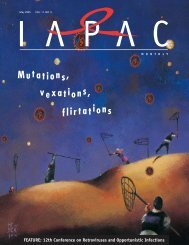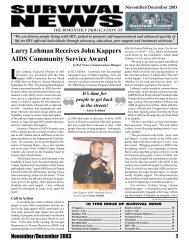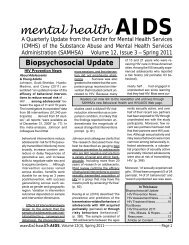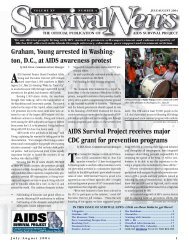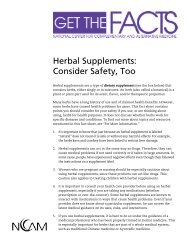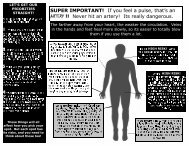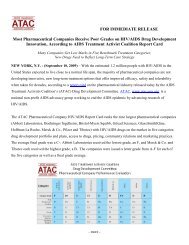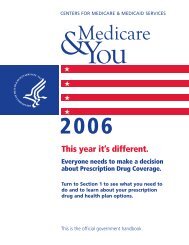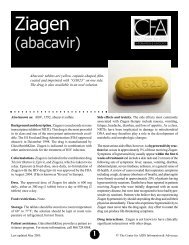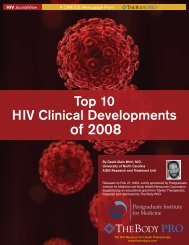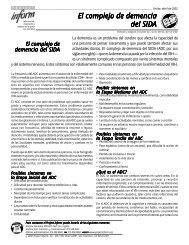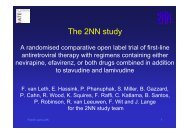PDF (2 MB) - National Institute on Drug Abuse
PDF (2 MB) - National Institute on Drug Abuse
PDF (2 MB) - National Institute on Drug Abuse
You also want an ePaper? Increase the reach of your titles
YUMPU automatically turns print PDFs into web optimized ePapers that Google loves.
from the director<br />
N A T I O N A L I N S T I T U T E O N D R U G A B U S E<br />
Research Report<br />
S E R I E S<br />
The abuse of methamphetamine—<br />
a potent and highly addictive psychostimulant—is<br />
a very serious problem<br />
in the United States. Initially limited<br />
to Hawaii and western parts of the<br />
country, methamphetamine abuse<br />
c<strong>on</strong>tinues to spread eastward, with<br />
rural and urban areas everywhere<br />
increasingly affected. According to<br />
<strong>on</strong>e nati<strong>on</strong>al survey, approximately<br />
10 milli<strong>on</strong> people in the United States<br />
have tried methamphetamine at<br />
least <strong>on</strong>ce.<br />
Methamphetamine abuse leads to<br />
devastating medical, psychological,<br />
and social c<strong>on</strong>sequences. Adverse<br />
health effects include memory loss,<br />
aggressi<strong>on</strong>, psychotic behavior, heart<br />
damage, malnutriti<strong>on</strong>, and severe<br />
dental problems. Methamphetamine<br />
abuse also c<strong>on</strong>tributes to increased<br />
transmissi<strong>on</strong> of infectious diseases,<br />
such as hepatitis and HIV/AIDS, and<br />
can infuse whole communities with<br />
new waves of crime, unemployment,<br />
child neglect or abuse, and other<br />
social ills.<br />
The good news is that methamphetamine<br />
abuse can be prevented<br />
and methamphetamine addicti<strong>on</strong><br />
can be treated. People do recover,<br />
but <strong>on</strong>ly when effective treatments<br />
that address the multitude of problems<br />
resulting from methamphetamine<br />
abuse are readily available. Primary<br />
goals of the <str<strong>on</strong>g>Nati<strong>on</strong>al</str<strong>on</strong>g> <str<strong>on</strong>g>Institute</str<strong>on</strong>g> <strong>on</strong><br />
<strong>Drug</strong> <strong>Abuse</strong> (NIDA) are to apply<br />
what our scientists learn from<br />
drug abuse research to develop new<br />
and enhance existing treatment<br />
approaches and to bring these effective<br />
treatments to the communities<br />
that need them.<br />
In this report, we provide an overview<br />
of the latest scientific findings<br />
<strong>on</strong> methamphetamine. Our intent is<br />
to enlighten readers about the damaging<br />
effects of methamphetamine<br />
abuse and to inform preventi<strong>on</strong> and<br />
treatment efforts.<br />
Nora D.Volkow, M.D.<br />
Director<br />
<str<strong>on</strong>g>Nati<strong>on</strong>al</str<strong>on</strong>g> <str<strong>on</strong>g>Institute</str<strong>on</strong>g> <strong>on</strong> <strong>Drug</strong> <strong>Abuse</strong><br />
What is<br />
methamphetamine?<br />
Methamphetamine is a<br />
highly addictive stimulant<br />
that affects the<br />
central nervous system. Although<br />
most of the methamphetamine<br />
used in this country comes from<br />
foreign or domestic superlabs,<br />
the drug is also easily made in<br />
small clandestine laboratories,<br />
with relatively inexpensive overthe-counter<br />
ingredients. These<br />
factors combine to make meth-<br />
U.S. Department of Health and Human Services •<br />
METHAMPHETAMINE<br />
<strong>Abuse</strong> and Addicti<strong>on</strong><br />
Methamphetamine<br />
amphetamine a drug with high<br />
potential for widespread abuse.<br />
Methamphetamine is comm<strong>on</strong>ly<br />
known as “speed,” “meth,” and<br />
“chalk.” In its smoked form, it<br />
is often referred to as “ice,”<br />
“crystal,” “crank,” and “glass.” It<br />
is a white, odorless, bitter-tasting<br />
crystalline powder that easily<br />
dissolves in water or alcohol.<br />
The drug was developed early<br />
last century from its parent drug,<br />
<str<strong>on</strong>g>Nati<strong>on</strong>al</str<strong>on</strong>g> <str<strong>on</strong>g>Institute</str<strong>on</strong>g>s of Health
2NIDA RESEARCH REPORT SERIES<br />
amphetamine, and was used<br />
originally in nasal dec<strong>on</strong>gestants<br />
and br<strong>on</strong>chial inhalers. Like<br />
amphetamine, methamphetamine<br />
causes increased activity and<br />
talkativeness, decreased appetite,<br />
and a general sense of well-being.<br />
However, methamphetamine<br />
differs from amphetamine in<br />
that at comparable doses, much<br />
higher levels of methamphetamine<br />
get into the brain, making<br />
it a more potent stimulant drug.<br />
It also has l<strong>on</strong>ger lasting and<br />
more harmful effects <strong>on</strong> the<br />
central nervous system.<br />
Methamphetamine is a<br />
Schedule II stimulant, which<br />
means it has a high potential<br />
for abuse and is available <strong>on</strong>ly<br />
through a prescripti<strong>on</strong>. It is<br />
indicated for the treatment of<br />
narcolepsy (a sleep disorder)<br />
and attenti<strong>on</strong> deficit hyperactivity<br />
disorder; but these medical uses<br />
are limited, and the doses are<br />
much lower than those typically<br />
abused.<br />
What is the<br />
scope of<br />
methamphetamine<br />
abuse in the<br />
United States?<br />
NIDA’s Community<br />
Epidemiology Work<br />
Group (CEWG), an early<br />
warning network of researchers<br />
that provides informati<strong>on</strong> about<br />
the nature and patterns of drug<br />
abuse in 21 major areas of the<br />
Primary Methamphetamine/Amphetamine Admissi<strong>on</strong><br />
Rates per 100,000 Populati<strong>on</strong> Aged 12 and Over<br />
1992 1994<br />
1999 2002<br />
Source: Treatment Episode Data Set (TEDS), SAMHSA.<br />
U.S., reported in January 2006<br />
that methamphetamine c<strong>on</strong>tinues<br />
to be a problem in the West,<br />
with indicators persisting at high<br />
levels in H<strong>on</strong>olulu, San Diego,<br />
Seattle, San Francisco, and Los<br />
Angeles; and that it c<strong>on</strong>tinues<br />
to spread to other areas of the<br />
country, including both rural<br />
and urban secti<strong>on</strong>s of the South<br />
and Midwest. In fact, methamphetamine<br />
was reported to be<br />
the fastest growing problem in<br />
metropolitan Atlanta.<br />
According to the 2005 <str<strong>on</strong>g>Nati<strong>on</strong>al</str<strong>on</strong>g><br />
Survey <strong>on</strong> <strong>Drug</strong> Use and Health<br />
(NSDUH), an estimated 10.4 milli<strong>on</strong><br />
people age 12 or older (4.3<br />
percent of the populati<strong>on</strong>) have<br />
tried methamphetamine at some<br />
time in their lives. Approximately<br />
1.3 milli<strong>on</strong> reported past-year<br />
Incomplete Data
the growing impact of methamphetamine<br />
abuse in the country.<br />
The <strong>Drug</strong> <strong>Abuse</strong> Warning<br />
Network (DAWN), which collects<br />
informati<strong>on</strong> <strong>on</strong> drug-related<br />
episodes from hospital emergency<br />
departments (EDs) throughout<br />
the Nati<strong>on</strong>, has reported a<br />
greater than 50 percent increase<br />
in the number of ED visits related<br />
to methamphetamine abuse<br />
between 1995 and 2002, reaching<br />
approximately 73,000 ED visits,<br />
or 4 percent of all drug-related<br />
visits in 2004.<br />
Treatment admissi<strong>on</strong>s for<br />
methamphetamine abuse have<br />
also increased substantially. In<br />
1992, there were approximately<br />
21,000 treatment admissi<strong>on</strong>s in<br />
which methamphetamine/<br />
amphetamine was identified<br />
as the primary drug of abuse,<br />
representing more than 1 percent<br />
of all treatment admissi<strong>on</strong>s during<br />
the year. By 2004, the number<br />
of methamphetamine treatment<br />
admissi<strong>on</strong>s increased to greater<br />
than 150,000, representing 8<br />
percent of all admissi<strong>on</strong>s.<br />
Moreover, this increased<br />
involvement of methamphetamine<br />
in drug treatment admissi<strong>on</strong>s has<br />
also been spreading across the<br />
country. In 1992, <strong>on</strong>ly 5 states<br />
reported high rates of treatment<br />
admissi<strong>on</strong>s (i.e., >24 per 100,000<br />
populati<strong>on</strong>) for primary methamphetamine/amphetamine<br />
problems; by 2002, this number<br />
increased to 21, more than a<br />
third of the states.<br />
How is<br />
methamphetamine<br />
abused?<br />
Methamphetamine comes<br />
in many forms and can<br />
be smoked, snorted,<br />
injected, or orally ingested.<br />
The preferred method of<br />
methamphetamine abuse varies<br />
by geographical regi<strong>on</strong> and has<br />
changed over time. Smoking<br />
methamphetamine, which leads<br />
to very fast uptake of the drug<br />
in the brain, has become more<br />
comm<strong>on</strong> in recent years,<br />
amplifying methamphetamine’s<br />
addicti<strong>on</strong> potential and adverse<br />
health c<strong>on</strong>sequences.<br />
The drug also alters mood in<br />
different ways, depending <strong>on</strong><br />
how it is taken. Immediately<br />
after smoking the drug or injecting<br />
it intravenously, the user<br />
experiences an intense rush<br />
or “flash” that lasts <strong>on</strong>ly a few<br />
minutes and is described as<br />
extremely pleasurable. Snorting<br />
or oral ingesti<strong>on</strong> produces<br />
euphoria—a high but not an<br />
Methamphetamine<br />
Stimulant<br />
Man-made<br />
Smoking produces a l<strong>on</strong>g-lasting high<br />
50% of the drug is removed from<br />
the body in 12 hours<br />
Increases dopamine release and blocks<br />
dopamine re-uptake<br />
Limited medical use<br />
vs.<br />
NIDA RESEARCH REPORT SERIES3<br />
intense rush. Snorting produces<br />
effects within 3 to 5 minutes, and<br />
oral ingesti<strong>on</strong> produces effects<br />
within 15 to 20 minutes.<br />
As with similar stimulants,<br />
methamphetamine most often<br />
is used in a “binge and crash”<br />
pattern. Because the pleasurable<br />
effects of methamphetamine<br />
disappear even before the drug<br />
c<strong>on</strong>centrati<strong>on</strong> in the blood falls<br />
significantly—users try to maintain<br />
the high by taking more of<br />
the drug. In some cases, abusers<br />
indulge in a form of binging<br />
known as a “run,” foregoing<br />
food and sleep while c<strong>on</strong>tinuing<br />
abuse for up to several days.<br />
How is<br />
methamphetamine<br />
different from<br />
other stimulants,<br />
such as cocaine?<br />
Methamphetamine is<br />
structurally similar to<br />
amphetamine and the<br />
neurotransmitter dopamine, but<br />
Cocaine<br />
Stimulant and local anesthetic<br />
Plant-derived<br />
Smoking produces a brief high<br />
50% of the drug is removed from<br />
the body in 1 hour<br />
Blocks dopamine re-uptake<br />
Limited use as a local anesthetic in<br />
some surgical procedures
4NIDA RESEARCH REPORT SERIES<br />
it is quite different from cocaine.<br />
Although these stimulants have<br />
similar behavioral and physiological<br />
effects, there are some major<br />
differences in the basic mechanisms<br />
of how they work. In c<strong>on</strong>trast<br />
to cocaine, which is quickly<br />
removed and almost completely<br />
metabolized in the body,<br />
methamphetamine has a much<br />
l<strong>on</strong>ger durati<strong>on</strong> of acti<strong>on</strong> and a<br />
larger percentage of the drug<br />
remains unchanged in the body.<br />
This results in methamphetamine<br />
being present in the brain l<strong>on</strong>ger,<br />
which ultimately leads to prol<strong>on</strong>ged<br />
stimulant effects. And<br />
Dopamine Pathways<br />
In the brain, dopamine plays an important role in the regulati<strong>on</strong> of reward and movement. As part<br />
of the reward pathway, dopamine is manufactured in nerve cell bodies located within the ventral<br />
tegmental area (VTA) and is released in the nucleus accumbens and the prefr<strong>on</strong>tal cortex. Its motor<br />
functi<strong>on</strong>s are linked to a separate pathway, with cell bodies in the substantia nigra that manufacture<br />
and release dopamine into the striatum.<br />
although both methamphetamine<br />
and cocaine increase levels of<br />
the brain chemical dopamine,<br />
animal studies reveal much<br />
higher levels of dopamine<br />
following administrati<strong>on</strong> of<br />
methamphetamine due to the<br />
different mechanisms of acti<strong>on</strong><br />
within nerve cells in resp<strong>on</strong>se to<br />
these drugs. Cocaine prol<strong>on</strong>gs<br />
dopamine acti<strong>on</strong>s in the brain<br />
by blocking dopamine re-uptake.<br />
While at low doses, methamphetamine<br />
blocks dopamine<br />
re-uptake, methamphetamine<br />
also increases the release of<br />
dopamine, leading to much<br />
higher c<strong>on</strong>centrati<strong>on</strong>s in the<br />
synapse, which can be toxic to<br />
nerve terminals.<br />
What are the<br />
immediate<br />
(short-term)<br />
effects of<br />
methamphetamine<br />
abuse?<br />
As a powerful stimulant,<br />
methamphetamine, even<br />
in small doses, can<br />
increase wakefulness and<br />
physical activity and decrease<br />
appetite. Methamphetamine can<br />
also cause a variety of cardiovascular<br />
problems, including rapid<br />
heart rate, irregular heartbeat,<br />
and increased blood pressure.<br />
Hyperthermia (elevated body<br />
temperature) and c<strong>on</strong>vulsi<strong>on</strong>s<br />
may occur with methamphetamine<br />
overdose, and if not treated<br />
immediately, can result in death.<br />
Most of the pleasurable effects<br />
of methamphetamine are believed<br />
to result from the release of<br />
very high levels of the neurotransmitter<br />
dopamine. Dopamine<br />
is involved in motivati<strong>on</strong>, the<br />
experience of pleasure, and<br />
motor functi<strong>on</strong>, and is a comm<strong>on</strong><br />
mechanism of acti<strong>on</strong> for most<br />
drugs of abuse. The elevated<br />
release of dopamine produced<br />
by methamphetamine is also<br />
thought to c<strong>on</strong>tribute to the<br />
drug’s deleterious effects <strong>on</strong><br />
nerve terminals in the brain.
What are the<br />
l<strong>on</strong>g-term<br />
effects of<br />
methamphetamine<br />
abuse?<br />
L<strong>on</strong>g-term methamphetamine<br />
abuse has many negative<br />
c<strong>on</strong>sequences, including<br />
addicti<strong>on</strong>. Addicti<strong>on</strong> is a chr<strong>on</strong>ic,<br />
relapsing disease, characterized<br />
by compulsive drug seeking and<br />
use, accompanied by functi<strong>on</strong>al<br />
and molecular changes in the<br />
brain. In additi<strong>on</strong> to being<br />
addicted to methamphetamine,<br />
chr<strong>on</strong>ic abusers exhibit symptoms<br />
that can include anxiety, c<strong>on</strong>fusi<strong>on</strong>,<br />
insomnia, mood disturbances,<br />
and violent behavior.<br />
They also can display a number<br />
of psychotic features, including<br />
paranoia, visual and auditory<br />
hallucinati<strong>on</strong>s, and delusi<strong>on</strong>s<br />
(for example, the sensati<strong>on</strong> of<br />
insects creeping under the skin).<br />
Psychotic symptoms can sometimes<br />
last for m<strong>on</strong>ths or years<br />
after methamphetamine abuse<br />
has ceased, and stress has been<br />
shown to precipitate sp<strong>on</strong>taneous<br />
recurrence of methamphetamine<br />
psychosis in formerly psychotic<br />
methamphetamine abusers.<br />
With chr<strong>on</strong>ic abuse, tolerance<br />
to methamphetamine’s pleasurable<br />
effects can develop. In an<br />
effort to intensify the desired<br />
effects, abusers may take higher<br />
doses of the drug, take it more<br />
frequently, or change their<br />
method of drug intake. Withdrawal<br />
from methamphetamine<br />
occurs when a chr<strong>on</strong>ic abuser<br />
stops taking the drug; symptoms<br />
of withdrawal include depressi<strong>on</strong>,<br />
anxiety, fatigue, and an<br />
intense craving for the drug.<br />
Chr<strong>on</strong>ic methamphetamine<br />
abuse also significantly changes<br />
the brain. Specifically, brain<br />
Recovery of Brain Dopamine Transporters<br />
in Chr<strong>on</strong>ic Methamphetamine (METH) <strong>Abuse</strong>rs<br />
Normal C<strong>on</strong>trol METH <strong>Abuse</strong>r<br />
(1 m<strong>on</strong>th abstinence)<br />
Source: Volkow ND et al., Journal of Neuroscience 21:9414–9418, 2001.<br />
METH <strong>Abuse</strong>r<br />
(24 m<strong>on</strong>th abstinence)<br />
NIDA RESEARCH REPORT SERIES5<br />
imaging studies have dem<strong>on</strong>strated<br />
alterati<strong>on</strong>s in the activity<br />
of the dopamine system that are<br />
associated with reduced motor<br />
speed and impaired verbal<br />
learning. Recent studies in<br />
chr<strong>on</strong>ic methamphetamine<br />
Short-Term Effects<br />
May Include:<br />
■ Increased attenti<strong>on</strong> and<br />
decreased fatigue<br />
■ Increased activity and<br />
wakefulness<br />
■ Decreased appetite<br />
■ Euphoria and rush<br />
■ Increased respirati<strong>on</strong><br />
■ Rapid/irregular<br />
heartbeat<br />
■ Hyperthermia<br />
L<strong>on</strong>g-Term Effects<br />
May Include:<br />
■ Addicti<strong>on</strong><br />
■ Psychosis, including:<br />
• paranoia<br />
• hallucinati<strong>on</strong>s<br />
• repetitive motor<br />
activity<br />
■ Changes in brain<br />
structure and functi<strong>on</strong><br />
■ Memory loss<br />
■ Aggressive or violent<br />
behavior<br />
■ Mood disturbances<br />
■ Severe dental<br />
problems<br />
■ Weight loss
6NIDA RESEARCH REPORT SERIES<br />
abusers have also revealed<br />
severe structural and functi<strong>on</strong>al<br />
changes in areas of the brain<br />
associated with emoti<strong>on</strong> and<br />
memory, which may account<br />
for many of the emoti<strong>on</strong>al and<br />
cognitive problems observed in<br />
chr<strong>on</strong>ic methamphetamine<br />
abusers.<br />
Fortunately, some of the<br />
effects of chr<strong>on</strong>ic methamphetamine<br />
abuse appear to be, at<br />
least partially, reversible. A<br />
recent neuroimaging study<br />
showed recovery in some brain<br />
regi<strong>on</strong>s following prol<strong>on</strong>ged<br />
abstinence (2 years, but not 6<br />
m<strong>on</strong>ths). This was associated<br />
with improved performance <strong>on</strong><br />
motor and verbal memory tests.<br />
However, functi<strong>on</strong> in other<br />
brain regi<strong>on</strong>s did not display<br />
recovery even after 2 years of<br />
abstinence, indicating that some<br />
methamphetamine-induced<br />
changes are very l<strong>on</strong>g-lasting.<br />
Moreover, the increased risk of<br />
stroke from the abuse of<br />
methamphetamine can lead to<br />
irreversible damage to the brain.<br />
What are<br />
the risks of<br />
methamphetamine<br />
abuse during<br />
pregnancy?<br />
Prenatal exposure to<br />
methamphetamine may<br />
also be a problem in the<br />
United States. Although according<br />
to the NSDUH, less than 1 percent<br />
of pregnant women aged<br />
15–44 had used methamphetamine<br />
in the past year, any use<br />
am<strong>on</strong>g this populati<strong>on</strong> is of<br />
c<strong>on</strong>cern. Unfortunately, our<br />
knowledge of the effects of<br />
methamphetamine during pregnancy<br />
is limited. The few human<br />
studies that exist have shown<br />
increased rates of premature<br />
delivery, placental abrupti<strong>on</strong>,<br />
fetal growth retardati<strong>on</strong>, and<br />
heart and brain abnormalities.<br />
However, these studies are<br />
difficult to interpret due to<br />
methodological issues, such as<br />
small sample size and maternal<br />
use of other drugs. Ongoing<br />
research is c<strong>on</strong>tinuing to study<br />
developmental outcomes such<br />
as cogniti<strong>on</strong>, social relati<strong>on</strong>ships,<br />
motor skills, and medical<br />
status of children exposed to<br />
methamphetamine before birth.<br />
Are<br />
methamphetamine<br />
abusers at risk<br />
for c<strong>on</strong>tracting<br />
HIV/AIDS and<br />
hepatitis B and C?<br />
Increased HIV and hepatitis B<br />
and C transmissi<strong>on</strong> are<br />
c<strong>on</strong>sequences of increased<br />
methamphetamine abuse, not<br />
<strong>on</strong>ly in individuals who inject the<br />
drug, but also in n<strong>on</strong>injecting<br />
methamphetamine abusers.<br />
Am<strong>on</strong>g injecti<strong>on</strong> drug users,<br />
infecti<strong>on</strong> with HIV and other<br />
infectious diseases is spread<br />
primarily through the re-use of<br />
c<strong>on</strong>taminated syringes, needles,<br />
or other paraphernalia by more<br />
than <strong>on</strong>e pers<strong>on</strong>. However,<br />
regardless of how it is taken, the<br />
intoxicating effects of methamphetamine<br />
can alter judgment<br />
and inhibiti<strong>on</strong> and lead people<br />
to engage in unsafe behaviors.<br />
Methamphetamine has become<br />
associated with a culture of risky<br />
sexual behavior, both am<strong>on</strong>g<br />
men who have sex with men<br />
(MSM) and heterosexual populati<strong>on</strong>s.<br />
This link may be due to<br />
the fact that methamphetamine<br />
and related psychomotor<br />
stimulants can increase libido.<br />
Paradoxically, l<strong>on</strong>g-term<br />
methamphetamine abuse may be<br />
associated with decreased sexual<br />
functi<strong>on</strong>ing, at least in men.<br />
The combinati<strong>on</strong> of injecti<strong>on</strong> and<br />
sexual risk-taking may result in<br />
HIV becoming a greater problem<br />
am<strong>on</strong>g methamphetamine<br />
abusers than am<strong>on</strong>g opiate and<br />
other drug abusers, something<br />
that already seems to be occurring,<br />
according to some epidemiologic<br />
reports. For example,<br />
while the link between HIV<br />
infecti<strong>on</strong> and methamphetamine<br />
abuse has not yet been established<br />
for heterosexuals, data<br />
show an associati<strong>on</strong> between<br />
methamphetamine abuse and the<br />
spread of HIV am<strong>on</strong>g MSM.<br />
Methamphetamine abuse may<br />
also worsen the progressi<strong>on</strong> of
HIV and its c<strong>on</strong>sequences. In<br />
animal studies, methamphetamine<br />
increased viral replicati<strong>on</strong>; in<br />
human methamphetamine<br />
abusers, HIV caused greater<br />
neur<strong>on</strong>al injury and cognitive<br />
impairment compared with<br />
n<strong>on</strong>drug abusers.<br />
NIDA-funded research has<br />
found that, through drug abuse<br />
treatment, preventi<strong>on</strong>, and<br />
community-based outreach<br />
programs, drug abusers can<br />
change their HIV risk behaviors.<br />
<strong>Drug</strong> abuse can be eliminated<br />
and drug-related risk behaviors,<br />
such as needle-sharing and<br />
unsafe sexual practices, can<br />
be reduced significantly, thus<br />
decreasing the risk of exposure<br />
to HIV and other infectious<br />
diseases. Therefore, drug abuse<br />
treatment is HIV preventi<strong>on</strong>.<br />
What treatments<br />
are effective for<br />
methamphetamine<br />
abusers?<br />
At this time, the most<br />
effective treatments for<br />
methamphetamine addicti<strong>on</strong><br />
are behavioral therapies<br />
such as cognitive behavioral<br />
and c<strong>on</strong>tingency management<br />
interventi<strong>on</strong>s. For example, the<br />
Matrix Model, a comprehensive<br />
behavioral treatment approach<br />
that combines behavioral therapy,<br />
family educati<strong>on</strong>, individual<br />
counseling, 12-Step support,<br />
drug testing, and encouragement<br />
for n<strong>on</strong>drug-related activities,<br />
has been shown to be effective<br />
in reducing methamphetamine<br />
abuse. C<strong>on</strong>tingency management<br />
interventi<strong>on</strong>s, which provide<br />
tangible incentives in exchange<br />
for engaging in treatment and<br />
maintaining abstinence, have<br />
also been shown to be effective.<br />
There are currently no specific<br />
medicati<strong>on</strong>s that counteract the<br />
effects of methamphetamine or<br />
that prol<strong>on</strong>g abstinence from and<br />
reduce the abuse of methamphetamine<br />
by an individual<br />
addicted to the drug. However,<br />
there are a number of medicati<strong>on</strong>s<br />
that are FDA-approved for<br />
other illnesses that might also be<br />
useful in treating methamphetamine<br />
addicti<strong>on</strong>. Recent study<br />
findings reveal that bupropi<strong>on</strong>,<br />
the anti-depressant marketed<br />
as Wellbutrin, reduced the<br />
methamphetamine-induced<br />
“high” as well as drug cravings<br />
elicited by drug-related cues.<br />
This medicati<strong>on</strong> and others are<br />
currently in clinical trials, while<br />
new compounds are being<br />
developed and studied in<br />
preclinical models.<br />
Where can I get<br />
further scientific<br />
informati<strong>on</strong> about<br />
methamphetamine<br />
abuse?<br />
To learn more about<br />
methamphetamine and<br />
other drugs of abuse,<br />
c<strong>on</strong>tact the <str<strong>on</strong>g>Nati<strong>on</strong>al</str<strong>on</strong>g> Clearing-<br />
NIDA RESEARCH REPORT SERIES7<br />
house for Alcohol and <strong>Drug</strong><br />
Informati<strong>on</strong> (NCADI) at<br />
800–729–6686. Informati<strong>on</strong><br />
specialists are available to help<br />
you locate informati<strong>on</strong> and<br />
resources.<br />
Fact sheets, including<br />
InfoFacts, <strong>on</strong> the health effects of<br />
methamphetamine, other drugs<br />
of abuse, and other drug abuse<br />
topics are available <strong>on</strong> the NIDA<br />
Web site (www.drugabuse.gov),<br />
and can be ordered free of<br />
charge in English and Spanish<br />
from NCADI at www.health.org.<br />
Access informati<strong>on</strong><br />
<strong>on</strong> the Internet<br />
• What’s new <strong>on</strong> the NIDA Web site<br />
• Informati<strong>on</strong> <strong>on</strong> drugs of abuse<br />
• Publicati<strong>on</strong>s and communicati<strong>on</strong>s<br />
(including NIDA Notes)<br />
• Calendar of events<br />
• Links to NIDA organizati<strong>on</strong>al units<br />
• Funding informati<strong>on</strong><br />
(including program announcements<br />
and deadlines)<br />
• Internati<strong>on</strong>al activities<br />
• Links to related Web sites<br />
(access to Web sites of many other<br />
organizati<strong>on</strong>s in the field)<br />
NIDA Web Sites<br />
www.drugabuse.gov<br />
www.steroidabuse.gov<br />
www.clubdrugs.gov<br />
www.hiv.drugabuse.gov<br />
www.inhalant.drugabuse.gov<br />
NCADI<br />
Web Site: www.health.org<br />
Ph<strong>on</strong>e No.: 800-729-6686
8NIDA RESEARCH REPORT SERIES<br />
Glossary<br />
Addicti<strong>on</strong>: A chr<strong>on</strong>ic, relapsing disease,<br />
characterized by compulsive drug seeking<br />
and drug use and by neurochemical and<br />
molecular changes in the brain.<br />
Attenti<strong>on</strong> deficit hyperactivity<br />
disorder: A disorder that often presents in<br />
early childhood, characterized by inattenti<strong>on</strong>,<br />
hyperactivity, and impulsivity.<br />
Central nervous system (CNS): The brain<br />
and spinal cord.<br />
Craving: A powerful, often unc<strong>on</strong>trollable<br />
desire for drugs.<br />
Dopamine: A neurotransmitter present in<br />
regi<strong>on</strong>s of the brain that regulate movement,<br />
emoti<strong>on</strong>, motivati<strong>on</strong>, and feelings of<br />
pleasure.<br />
Narcolepsy: A disorder characterized by<br />
unc<strong>on</strong>trollable attacks of deep sleep.<br />
Psychomotor stimulants (psychostimulants):<br />
<strong>Drug</strong>s that increase or enhance the<br />
activity of m<strong>on</strong>oamines (such as dopamine<br />
and norepinephrine) in the brain.<br />
Psychostimulants increase arousal and<br />
activity, as well as heart rate, blood pressure,<br />
and respirati<strong>on</strong>.<br />
Psychosis: A mental disorder characterized<br />
by symptoms such as delusi<strong>on</strong>s or<br />
hallucinati<strong>on</strong>s and disordered thinking.<br />
Rush: A surge of euphoric pleasure that<br />
rapidly follows administrati<strong>on</strong> of a drug.<br />
Tolerance: A c<strong>on</strong>diti<strong>on</strong> in which higher<br />
doses of a drug are required to produce the<br />
same effect as experienced initially.<br />
Toxic: Damage to an organ or group of<br />
organs.<br />
Withdrawal: A variety of symptoms that<br />
occur after chr<strong>on</strong>ic abuse of an addictive<br />
drug is reduced or stopped.<br />
References<br />
Chang L, Ernst T, Speck O, Grob CS. Additive effects of<br />
HIV and chr<strong>on</strong>ic methamphetamine use <strong>on</strong> brain<br />
metabolite abnormalities. Am J Psychiatry<br />
162:361–369, 2005.<br />
Gavrilin MA, Mathes LE, Podell M. Methamphetamine<br />
enhances cell-associated feline immunodeficiency virus<br />
replicati<strong>on</strong> in astrocytes. J Neurovirol 8:240–249,<br />
2002.<br />
Huber A, Ling W, Shoptaw S, Gulati V, Brethen P, Raws<strong>on</strong><br />
R. Integrating treatments for methamphetamine<br />
abuse: A psychosocial perspective. J Addict Dis<br />
16(4):41–50, 1997.<br />
Johnst<strong>on</strong> LD, O’Malley PM, Bachman JG. M<strong>on</strong>itoring the<br />
Future: <str<strong>on</strong>g>Nati<strong>on</strong>al</str<strong>on</strong>g> Results <strong>on</strong> Adolescent <strong>Drug</strong> Use,<br />
Overview and Key Findings, 2005. NIH Pub. No. 05-<br />
5506, Bethesda, MD: NIDA, NIH, DHHS, 2005.<br />
L<strong>on</strong>d<strong>on</strong> ED, Sim<strong>on</strong> SL, Berman SM, Mandelkern MA,<br />
Lichtman AM, Bramen J, Shinn AK, Miotto K, Learn J,<br />
D<strong>on</strong>g Y, Matochik JA, Kurian V, Newt<strong>on</strong> T, Woods R,<br />
Raws<strong>on</strong> R, Ling W. Mood disturbances and regi<strong>on</strong>al<br />
cerebral metabolic abnormalities in recently abstinent<br />
methamphetamine abusers. Arch Gen Psychiatry<br />
61:73–84, 2004.<br />
<str<strong>on</strong>g>Nati<strong>on</strong>al</str<strong>on</strong>g> <str<strong>on</strong>g>Institute</str<strong>on</strong>g> <strong>on</strong> <strong>Drug</strong> <strong>Abuse</strong>. Epidemiologic Trends<br />
in <strong>Drug</strong> <strong>Abuse</strong>: Advance Report, Community<br />
Epidemiology Work Group, January 2006. NIH Pub.<br />
No. 06-5878, Bethesda, MD: NIH, DHHS, 2006.<br />
<str<strong>on</strong>g>Nati<strong>on</strong>al</str<strong>on</strong>g> <str<strong>on</strong>g>Institute</str<strong>on</strong>g> <strong>on</strong> <strong>Drug</strong> <strong>Abuse</strong>. Epidemiologic Trends in<br />
<strong>Drug</strong> <strong>Abuse</strong>: Vol. I., Proceedings of the Community<br />
Epidemiology Work Group, Highlights and Executive<br />
Summary, January 2006. NIH Pub. No. 06-5879,<br />
Bethesda, MD: NIH, DHHS, 2006.<br />
<str<strong>on</strong>g>Nati<strong>on</strong>al</str<strong>on</strong>g> <str<strong>on</strong>g>Institute</str<strong>on</strong>g> <strong>on</strong> <strong>Drug</strong> <strong>Abuse</strong>. Epidemiologic Trends in<br />
<strong>Drug</strong> <strong>Abuse</strong>: Vol. II., Proceedings of the Community<br />
Epidemiology Work Group, January 2006. NIH Pub.<br />
No. 06-5880, Bethesda, MD: NIH, DHHS, 2006.<br />
Petry NM, Peirce JM, Stitzer ML, Blaine J, Roll JM, Cohen<br />
A. Obert J, Killeen T, Saladin ME, Cowell M, Kirby KC,<br />
Sterling R, Royer-Malvestuto C, Hamilt<strong>on</strong> J, Booth RE,<br />
Macd<strong>on</strong>ald M, Liebert M, Rader L, Burns R, DiMaria J,<br />
Copersino M, Stabile PQ, Kolodner K, Li R. Effect of<br />
prize-based incentives <strong>on</strong> outcomes in stimulant<br />
abusers in outpatient psychosocial treatment<br />
programs: a nati<strong>on</strong>al drug abuse treatment clinical<br />
trials network study. Arch Gen Psychiatry<br />
62(10):1148–1156, 2005.<br />
Raws<strong>on</strong> RA, Marinelli-Casey P, Anglin MD, Dickow A,<br />
Frazier Y, Gallagher C, Galloway GP, Herrell J, Huber<br />
A, McCann MJ, Obert J, Pennell S, Reiber C,<br />
Vandersloot D, Zweben J. A multi-site comparis<strong>on</strong><br />
of psychosocial approaches for the treatment of<br />
methamphetamine dependence. Addicti<strong>on</strong><br />
99:708–717, 2003.<br />
Rippeth JD, Heat<strong>on</strong> RK, Carey CL, Marcotte TD, Moore DJ,<br />
G<strong>on</strong>zalez R, Wolfs<strong>on</strong> T, Grant I. Methamphetamine<br />
dependence increases risk of neuropsychological<br />
impairment in HIV infected pers<strong>on</strong>s. J Int<br />
Neuropsychol Soc 10:1–14, 2004.<br />
Substance <strong>Abuse</strong> and Mental Health Services<br />
Administrati<strong>on</strong> (SAMHSA). Results from the 2005<br />
<str<strong>on</strong>g>Nati<strong>on</strong>al</str<strong>on</strong>g> Survey <strong>on</strong> <strong>Drug</strong> Use and Health. NSDUH<br />
Series H-30. DHHS Pub No. SMA 06-4194, Rockville,<br />
MD: DHHS, 2006.<br />
SAMHSA. Office of Applied Studies. <strong>Drug</strong> <strong>Abuse</strong> Warning<br />
Network, 2004: <str<strong>on</strong>g>Nati<strong>on</strong>al</str<strong>on</strong>g> Estimates of <strong>Drug</strong>-Related<br />
Emergency Department Visits. DAWN Series D-28,<br />
DHHS Pub No. 06-4143, Rockville, MD: DHHS,<br />
2006.<br />
SAMHSA, Office of Applied Studies. Treatment Episode<br />
Data Set (TEDS). Highlights - 2004. <str<strong>on</strong>g>Nati<strong>on</strong>al</str<strong>on</strong>g><br />
Admissi<strong>on</strong>s to Substance <strong>Abuse</strong> Treatment Services,<br />
DASIS Series: S-31, DHHS Publicati<strong>on</strong> No. (SMA) 06-<br />
4140, Rockville, MD: DHHS, 2006.<br />
Thomps<strong>on</strong> PM, Hayashi KM, Sim<strong>on</strong> SL, Geaga JA, H<strong>on</strong>g<br />
MS, Sui Y, Lee JY, Toga AW, Ling W, L<strong>on</strong>d<strong>on</strong> ED.<br />
Structural abnormalities in the brains of human<br />
subjects who use methamphetamine. J Neurosci<br />
24:6028–6036, 2004.<br />
Volkow ND, et al. Associati<strong>on</strong> of dopamine transporter<br />
reducti<strong>on</strong> with psychomotor impairment in<br />
methamphetamine abusers. Am J Psychiatry<br />
158(3):377–382, 2001.<br />
Volkow ND, et al. Loss of dopamine transporters in<br />
methamphetamine abusers recovers with protracted<br />
abstinence. J Neurosci 21(23):9414–9418, 2001.<br />
Wang G-J, et al. Partial recovery of brain metabolism<br />
in methamphetamine abusers after protracted<br />
abstinence. Am J Psychiatry 161(2):242–248,<br />
2004.<br />
Wouldes T, LaGasse L, Sheridan J, Lester B. Maternal<br />
methamphetamine use during pregnancy and child<br />
outcome: what do we know? N Z Med J 117:U1180,<br />
2004.<br />
NIH Publicati<strong>on</strong> Number 06-4210<br />
Printed April 1998, Reprinted January 2002.<br />
Revised September 2006.<br />
Feel free to reprint this publicati<strong>on</strong>.



